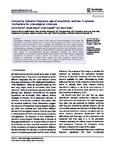Comparing phoneme frequency, age of acquisition, and loss in aphasia: Implications for phonological universals
| dc.contributor.author | Romani, C | |
| dc.contributor.author | Galuzzi, C | |
| dc.contributor.author | Guariglia, C | |
| dc.contributor.author | Goslin, Jeremy | |
| dc.date.accessioned | 2018-02-19T09:59:49Z | |
| dc.date.issued | 2017-09-15 | |
| dc.identifier.issn | 0264-3294 | |
| dc.identifier.issn | 1464-0627 | |
| dc.identifier.uri | http://hdl.handle.net/10026.1/10814 | |
| dc.description | peerreview_statement: The publishing and review policy for this title is described in its Aims & Scope. aims_and_scope_url: http://www.tandfonline.com/action/journalInformation?show=aimsScope&journalCode=pcgn20 | |
| dc.description.abstract |
Phonological complexity may be central to the nature of human language. It may shape the distribution of phonemes and phoneme sequences within languages, but also determine age of acquisition and susceptibility to loss in aphasia. We evaluated this claim using frequency statistics derived from a corpus of phonologically transcribed Italian words (phonitalia, available at phonitalia,org), rankings of phoneme age of acquisition (AoA) and rate of phoneme errors in patients with apraxia of speech (AoS) as an indication of articulatory complexity. These measures were related to cross-linguistically derived markedness rankings. We found strong correspondences. AoA, however, was predicted by both apraxic errors and frequency, suggesting independent contributions of these variables. Our results support the reality of universal principles of complexity. In addition they suggest that these complexity principles have articulatory underpinnings since they modulate the production of patients with AoS, but not the production of patients with more central phonological difficulties. | |
| dc.format.extent | 1-23 | |
| dc.format.medium | Print-Electronic | |
| dc.language | en | |
| dc.language.iso | en | |
| dc.publisher | Informa UK Limited | |
| dc.subject | Aphasic errors | |
| dc.subject | featural markedness | |
| dc.subject | phoneme acquisition | |
| dc.subject | phoneme frequencies | |
| dc.title | Comparing phoneme frequency, age of acquisition, and loss in aphasia: Implications for phonological universals | |
| dc.type | journal-article | |
| dc.type | Journal Article | |
| plymouth.author-url | https://www.webofscience.com/api/gateway?GWVersion=2&SrcApp=PARTNER_APP&SrcAuth=LinksAMR&KeyUT=WOS:000425682500008&DestLinkType=FullRecord&DestApp=ALL_WOS&UsrCustomerID=11bb513d99f797142bcfeffcc58ea008 | |
| plymouth.issue | 7-8 | |
| plymouth.volume | 34 | |
| plymouth.publication-status | Published | |
| plymouth.journal | Cognitive Neuropsychology | |
| dc.identifier.doi | 10.1080/02643294.2017.1369942 | |
| plymouth.organisational-group | /Plymouth | |
| plymouth.organisational-group | /Plymouth/Faculty of Health | |
| plymouth.organisational-group | /Plymouth/Faculty of Health/School of Psychology | |
| plymouth.organisational-group | /Plymouth/REF 2021 Researchers by UoA | |
| plymouth.organisational-group | /Plymouth/REF 2021 Researchers by UoA/UoA04 Psychology, Psychiatry and Neuroscience | |
| plymouth.organisational-group | /Plymouth/REF 2021 Researchers by UoA/UoA04 Psychology, Psychiatry and Neuroscience/UoA04 REF peer reviewers | |
| plymouth.organisational-group | /Plymouth/Research Groups | |
| plymouth.organisational-group | /Plymouth/Research Groups/Centre for Brain, Cognition and Behaviour (CBCB) | |
| plymouth.organisational-group | /Plymouth/Research Groups/Centre for Brain, Cognition and Behaviour (CBCB)/Brain | |
| plymouth.organisational-group | /Plymouth/Users by role | |
| plymouth.organisational-group | /Plymouth/Users by role/Academics | |
| dc.publisher.place | England | |
| dcterms.dateAccepted | 2017-08-03 | |
| dc.identifier.eissn | 1464-0627 | |
| dc.rights.embargoperiod | Not known | |
| rioxxterms.versionofrecord | 10.1080/02643294.2017.1369942 | |
| rioxxterms.licenseref.uri | http://www.rioxx.net/licenses/all-rights-reserved | |
| rioxxterms.licenseref.startdate | 2017-09-15 | |
| rioxxterms.type | Journal Article/Review |


